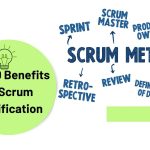Don’t know how to scale your business? We present to you the Scrum At Scale Detailed Guide, here is how you can discover how to expand Scrum for your entire organization while staying Agile and efficient.

What is Scrum at Scale?
Scrum at Scale (S@S), is an agile framework that is specially designed to scale Scrum practices all through a large organization. One of Scrum’s co-creators, Dr. Jeff Sutherland, discovered this framework. He wanted Scrum to stretch its capabilities on foundational principles to reach more teams. By doing so, organizations can maintain agility at a larger scale. If you’re unsure whether S@S fits your team size or structure, it may help to first see how it compares to other popular scaled agile frameworks.
With Scrum at Scale, expanding from one scrum team to many is now possible, allowing your enterprise to utilize the full advantages of Scrum without giving up anything.
BECOME A CERTIFIED SCRUM EXPERT – START YOUR JOURNEY TODAY!
How Does Scrum at Scale Work?
So, you may be wondering how S@S works, we got you! Scrum at Scale tends to enable large organizations to utilize Scrum principles and its practices across the multiple teams of the organization. Here is how this works.
Scale-Free design: Scrum@Scale encourages a more adaptable, scale-free design in contrast to conventional frameworks that enforce a top-down structure. Teams maintain their autonomy while avoiding superfluous bureaucracy.
Ecosystem of Teams: S@S creates networks of Scrum teams to work together without introducing more levels of administration. The same principles of Scrum—openness, boldness, focus, respect, and commitment—are upheld by autonomous teams.
Minimum Viable Bureaucracy (MVB): S@S ensures that adding more teams doesn’t result in complexity by keeping bureaucracy to a minimum. Agile techniques can flourish in wider environments thanks to this strategy, which has been made famous by businesses like Spotify.
What are the Key Roles in Scrum at Scale?
From newbies to experts, Scrum at Scale has roles you can fill depending on your area of expertise. With the introduction of additional roles, managing larger teams has become easier as you can keep and maintain the core Scrum roles intact. Here are the roles:
- The Scrum of Scrums Master (SoSM): In charge of coordinating the efforts of several Scrum teams, facilitating seamless coordination and cooperation.
- Chief Product Owner (CPO): The CPO oversees the product backlog for all teams, coordinates sprint objectives, and manages deliverables, much like a traditional Product Owner but at a larger scale.
- Executive Action Team (EAT): For larger businesses, the EAT ensures that roadblocks are quickly and effectively removed, enabling ongoing value creation.
How to Get Started with Scrum at Scale
When you are getting started with Scrum at Scale, you are required to know these few critical steps:
- Evaluate Organizational Needs: Find out which teams can most benefit from Scrum@Scale and where it fits in with your organization.
- Put Minimum Viable Bureaucracy (MVB) into Practice: To guarantee that your teams can function effectively, concentrate on eliminating superfluous levels of administration.
- Develop Key Roles: Make sure executives, product owners, and scrum masters are aware of their responsibilities in a scaled context.
- Track Progress: Using daily scrums and retrospectives for all teams, evaluate Scrum at Scale’s efficacy regularly.
Scrum at Scale vs. Other Scaling Frameworks
While Scrum is highly reputed, a very powerful and flexible framework which will not only help teams scale but also overcome certain issues. It is best to see how it compares to the popular scaling frameworks like SAFe and LeSS.
- Scrum at Scale vs SAFe: SAFe introduces more layers of complexity with additional roles, practices, and ceremonies. On the other hand, Scrum at Scale is about simplicity and flexibility. It makes organizations scale without adding unnecessary overhead.
- Scrum at Scale vs LeSS: In contrast to LeSS, which insists on scaling Scrum with the same structure for all teams, Scrum at Scale emphasizes an ecosystem of interconnected teams, which then provides flexibility in scaling across multiple teams.
With the strength each framework offers, Scrum at Scale is the most streamlined for an organization to scale without losing its Agile
Why You Should Choose ValueX2 for Scrum at Scale Training
When choosing the best institute to take your Agile certification courses, you need to have in mind which course can give you the best results, and which course suits your organizational requirements. Here at ValueX2, we are ready to hold your hand through this agile transformation journey with our globally recognized certifications. Selecting ValueX2 for your Scrum at Scale training comes with its advantages, here are some:
Expert Trainers: Gain knowledge from Scrum@Scale certified specialists with practical expertise.
Flexible Learning Options: To accommodate your hectic schedule, access live and online training programs.
Customized Courses: Our courses are made to fit your specific organizational needs, regardless of whether you’re new to Scrum or scaling for the first time.
Upcoming Training with ValueX2
Join our upcoming training courses to become the next Agile expert, for you to scale Scrum for large organizations. You will be guided hand in hand by our seasoned professionals who have gained over ten years of experience with real-world challenges. Sign up for a course now!
By understanding Scrum at Scale, your organization stands a chance of achieving the efficiency and collaboration needed to thrive in the current evolving business market. So, are you ready to become the game changer in your organization? Scale your Agile practices today by joining our training sessions at ValueX2 and becoming an expert!
Are you looking for more insights? Explore our other blogs:
- Agile Frameworks List: A Brief Guide for Agile Aspirants
- Scaling Agile Frameworks Compared! Which One Should You Choose
FAQs on Scrum at Scale
Q: What does Scrum of Scrums mean?
A: Scrum of Scrums (SoS) is a scaled version of Scrum that consists of a number of teams working together to provide greater work increments while adhering to the core Scrum procedures.
Q: What distinguishes SAFe from Scrum at Scale?
A: While scaling Scrum is the main goal of both frameworks, SAFe adds extra layers of complexity, whereas Scrum at Scale aims to keep things as straightforward and bureaucrat-free as possible.
Q: How many teams can use Scrum at Scale?
A: There is no set limit to the number of teams that can use S@S. Designed to fit one team to several teams, this is a framework for a team of teams.
Q: What are the best tools for managing Scrum at Scale?
A: There are several tools available for you. Tools like Jira, Confluence, and others, which are personalized to Scrum, are considered the best for managing Scrum at Scale. Such tools are essential for successful scaling.
Q: How long does it take to implement Scrum at Scale?
The time may change, this depends on your firm’s size and preparedness. However, with the right training (ValueX2), you can start witnessing positive change fast.

Bhavna is an Agile Coach and Consultant with 15+ years of experience in advisory, corporate finance, IT assurance, and operations at Big 4 and within the industry in the UK and India. She has recently been the CEO of a start-up where she implemented agile practices within HR, Marketing, and Product teams.
She is also a SAFe® Practice Consultant (SPC) and authorized instructor for ICAgile Agility in HR (ICP-AHR), Agility in Marketing (ICP-MKG), and Business Agility Foundations (ICP – BAF) training courses. She provides training for agile transformation to corporate, public, and private batches, as well as consulting for enterprise agile transformation.






